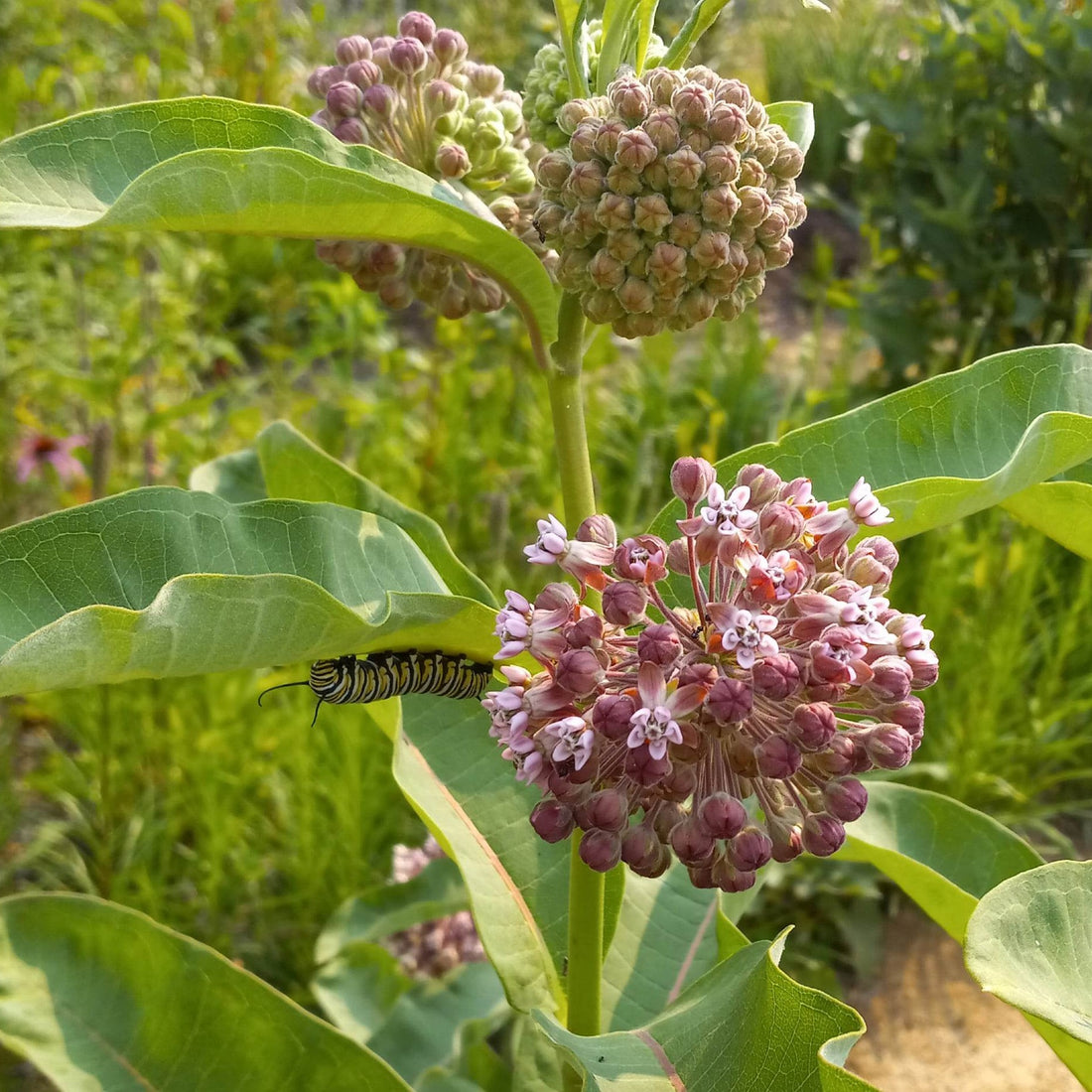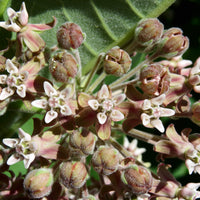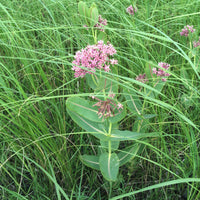
- When to plant:
- Spring, Fall
- Fertilizer:
- Varies
- Seeding rate:
- 8 - 10 lbs. per acre
- Overseeding rate:
- 4 oz per 1,000 sq. ft.
- Seeding depth:
- 1/8 - 1/4 inch
- Ideal ph:
- 5.5 - 7.8
- Gmo:
- No
- Inoculant needed:
- No
- Coated or raw:
- Raw
- Lifecycle:
- Perennial
- Climate zones:
- Cool Season, Transition Zone, Warm Season
Common Milkweed is a well-known perennial plant native to North America. It's an essential plant for monarch butterflies and has distinct characteristics. This milkweed species features clusters of small, fragrant, pink to purplish flowers arranged in large, rounded clusters. The flowers have a unique structure with intricate petals and a central crown-like structure. The plant blooms from late spring to mid-summer.
Product Information
- Botanic Name: Asclepias syriaca
- Application or Use: Ornamental, Conservation, Habitat
- Germination Time: 10 - 14 days, under optimal conditions
- Growing Locations: Warm Season, Transition Zone, Cool Season
- Height: 3 - 5 feet
- Sunlight Requirements: 8+ hours, full sun for best results
- Advantages: Adapted to many soil types; showy blooms, excellent for landscaping; attracts pollinators.
- When to Plant: See instructions tab.
Product Information
Common Milkweed is a well-known perennial plant native to North America. It's an essential plant for monarch butterflies and has distinct characteristics. This milkweed species features clusters of small, fragrant, pink to purplish flowers arranged in large, rounded clusters. The flowers have a unique structure with intricate petals and a central crown-like structure. The plant blooms from late spring to mid-summer.
Common Milkweed typically grows between 3 to 6 feet in height, with thick, upright stems. It can spread through rhizomes and forms colonies, creating patches of these tall plants in suitable habitats.
The plant has broad, oblong-shaped leaves that are oppositely arranged along the stem. The leaves are a deep green color and emit a milky sap when broken, which is characteristic of milkweed plants.
Common Milkweed thrives in various soil types but prefers well-drained, moderately moist soil. It's tolerant of dry conditions once established and is commonly found in fields, meadows, roadsides, and disturbed areas.
This milkweed species is crucial for monarch butterflies as it serves as a host plant for their caterpillars. Monarch butterflies lay their eggs on the leaves, and the caterpillars feed exclusively on milkweed. The flowers also attract other pollinators like bees and butterflies.
Common Milkweed is often grown in butterfly gardens and wildlife habitats to support monarch populations. However, it can spread vigorously, so it's essential to plant it where its tendency to colonize won't cause issues.
Due to threats to monarch butterfly populations, efforts to cultivate milkweed plants, including Common Milkweed, have increased to provide essential habitats for monarchs during their life cycle.
Common Milkweed is an ecologically significant plant due to its role in supporting monarch butterflies and other pollinators. It's valued for its beauty, ecological importance, and its contribution to conservation efforts aimed at preserving butterfly populations.
*Product packaging may appear different than what is pictured.
Wildflower Planting Time Based on Region:
Southeast
- Fall, Winter: Sowing wildflowers in Fall/Winter is the ideal time in the Southeast, with October 1 – December 31 being the best dates. The weather is ideal for starting seeds, and seedlings can grow and harden off before frost.
- Spring: A good time to plant wildflowers, especially annual species that flower quickly. Plant after the last frost date when soil temperatures have warmed to around 55°F, typically occurring within a month or so after the final frost of winter; this ensures the seeds can germinate properly without being affected by cold weather.
- Summer: You can plant wildflower seeds in the summer, but the hot sun can dry out the soil and stress your seedlings. Summer is a good time to plant quick-growing annual wildflowers.
Southwest
- Fall: A good time to plant spring wildflowers in the desert Southwest. Fall's cooler temperatures and seasonal rains help seeds germinate. In the mountains, you can plant after spring frosts.
- Winter: In areas that get snow, winter seeding can give seeds an advantage in the spring.
- Spring: A popular time to plant wildflowers in most states. You can plant after the last frost and when the soil temperature is at least 55°F. In warmer climates, you can plant at the end of the rainy season.
- Summer: You can plant wildflower seeds in the summer, but the hot sun can dry out the soil and stress your seedlings. Summer is a good time to plant quick-growing annual wildflowers.
Northeast
- Fall, Winter: The best time to plant wildflowers in the Northeast is in late fall, after the first frost but before heavy snow. This is known as dormant seeding and can take place from November to December. Cold temperatures and damp soil during the winter help wildflower seeds germinate.
- Spring: Plant in early spring, after the ground has thawed and soil temperatures reach around 55-65°F. This is a popular time to plant wildflowers because it's typically rainier, which helps water seedlings.
- Summer: You can plant wildflower seeds in the summer, but the hot sun can dry out the soil and stress your seedlings. Summer is a good time to plant quick-growing annual wildflowers.
Midwest
- Fall, Winter: Plant in late fall (November–December) after the first frost. The seeds will overwinter and germinate in the spring. Fall planting is a good option for cooler climates and can give the seeds an early start in the spring.
- Spring: Plant in early spring (April–May) after the last frost when the soil temperature is consistently above 55°F. Spring is a popular time to plant because the soil is usually moist from rain, and you can see the wildflowers grow right away.
- Summer: You can plant wildflower seeds in the summer, but the hot sun can dry out the soil and stress your seedlings. Summer is a good time to plant quick-growing annual wildflowers.
Western
- Fall, Winter: Plant in late fall (November–December) after the first frost. The seeds will overwinter and germinate in the spring. Fall planting is a good option for cooler climates and can give the seeds an early start in the spring.
- Spring: Plant in early spring (April–May) after the last frost when the soil temperature is consistently above 55°F. Spring is a popular time to plant because the soil is usually moist from rain, and you can see the wildflowers grow right away.
- Summer: You can plant wildflower seeds in the summer, but the hot sun can dry out the soil and stress your seedlings. Summer is a good time to plant quick-growing annual wildflowers.
Pacific Northwest
- Fall, Winter: Plant in late fall (November–December) after the first frost. The seeds will overwinter and germinate in the spring. Fall planting is a good option for cooler climates and can give the seeds an early start in the spring.
- Spring: Plant in early spring (April–May) after the last frost when the soil temperature is consistently above 55°F. Spring is a popular time to plant because the soil is usually moist from rain, and you can see the wildflowers grow right away.
- Summer: In cooler zones with higher elevation, you can plant wildflowers in late spring to early summer, after the risk of frost has passed. You can plant wildflower seeds in the summer, but the hot sun can dry out the soil and stress your seedlings. Summer is a good time to plant quick-growing annual wildflowers.
When choosing to start a new lawn, remove old vegetation by using a de-thatcher, power rake or tiller to kill the existing vegetation. Rake or drag the area to remove debris and dead grass for a clean area. Ensure the soil is leveled and loosened to allow the seed to have good soil contact once spread on a clean seed bed.
If you have an area with heavy weed coverage, we recommend starting fresh by killing and removing the existing vegetation. If you choose to use chemicals, herbicides or fertilizers, you must check with the product's manufacturer prior to planting new seed to ensure the proper waiting period.
When overseeding an existing area, mow your lawn at the lowest setting and bag the clippingsx. Rake or drag any areas that have dead thatch or debris.

Seed Quality
Hancock Seed is dedicated to delivering the best seeds possible to our customers. Hancock Seed grows and harvests many of our products, and we acquire the majority of the rest from other family farmers.
All these seeds are processed, packaged and shipped from Hancock Farm. This helps us ensure that our high standards are met. Unlike much of the competition, we refuse to sell you a seed that was not gathered during the last harvest. You will always receive fresh product from Hancock.
Every seed we grow comes with 40 years of experience behind it...you can rest assured that all of our products are cultivated in a method that assures its potential for growth.

Your cart ( 0 )

Common Milkweed is a well-known perennial plant native to North America. It's an essential plant for monarch butterflies and has distinct characteristics. This milkweed species features clusters of small, fragrant, pink to purplish flowers arranged in large, rounded clusters. The flowers have a unique structure with intricate petals and a central crown-like structure. The plant blooms from late spring to mid-summer.
Product Information
- Botanic Name: Asclepias syriaca
- Application or Use: Ornamental, Conservation, Habitat
- Germination Time: 10 - 14 days, under optimal conditions
- Growing Locations: Warm Season, Transition Zone, Cool Season
- Height: 3 - 5 feet
- Sunlight Requirements: 8+ hours, full sun for best results
- Advantages: Adapted to many soil types; showy blooms, excellent for landscaping; attracts pollinators.
- When to Plant: See instructions tab.
Product Information
Common Milkweed is a well-known perennial plant native to North America. It's an essential plant for monarch butterflies and has distinct characteristics. This milkweed species features clusters of small, fragrant, pink to purplish flowers arranged in large, rounded clusters. The flowers have a unique structure with intricate petals and a central crown-like structure. The plant blooms from late spring to mid-summer.
Common Milkweed typically grows between 3 to 6 feet in height, with thick, upright stems. It can spread through rhizomes and forms colonies, creating patches of these tall plants in suitable habitats.
The plant has broad, oblong-shaped leaves that are oppositely arranged along the stem. The leaves are a deep green color and emit a milky sap when broken, which is characteristic of milkweed plants.
Common Milkweed thrives in various soil types but prefers well-drained, moderately moist soil. It's tolerant of dry conditions once established and is commonly found in fields, meadows, roadsides, and disturbed areas.
This milkweed species is crucial for monarch butterflies as it serves as a host plant for their caterpillars. Monarch butterflies lay their eggs on the leaves, and the caterpillars feed exclusively on milkweed. The flowers also attract other pollinators like bees and butterflies.
Common Milkweed is often grown in butterfly gardens and wildlife habitats to support monarch populations. However, it can spread vigorously, so it's essential to plant it where its tendency to colonize won't cause issues.
Due to threats to monarch butterfly populations, efforts to cultivate milkweed plants, including Common Milkweed, have increased to provide essential habitats for monarchs during their life cycle.
Common Milkweed is an ecologically significant plant due to its role in supporting monarch butterflies and other pollinators. It's valued for its beauty, ecological importance, and its contribution to conservation efforts aimed at preserving butterfly populations.
*Product packaging may appear different than what is pictured.
Wildflower Planting Time Based on Region:
Southeast
- Fall, Winter: Sowing wildflowers in Fall/Winter is the ideal time in the Southeast, with October 1 – December 31 being the best dates. The weather is ideal for starting seeds, and seedlings can grow and harden off before frost.
- Spring: A good time to plant wildflowers, especially annual species that flower quickly. Plant after the last frost date when soil temperatures have warmed to around 55°F, typically occurring within a month or so after the final frost of winter; this ensures the seeds can germinate properly without being affected by cold weather.
- Summer: You can plant wildflower seeds in the summer, but the hot sun can dry out the soil and stress your seedlings. Summer is a good time to plant quick-growing annual wildflowers.
Southwest
- Fall: A good time to plant spring wildflowers in the desert Southwest. Fall's cooler temperatures and seasonal rains help seeds germinate. In the mountains, you can plant after spring frosts.
- Winter: In areas that get snow, winter seeding can give seeds an advantage in the spring.
- Spring: A popular time to plant wildflowers in most states. You can plant after the last frost and when the soil temperature is at least 55°F. In warmer climates, you can plant at the end of the rainy season.
- Summer: You can plant wildflower seeds in the summer, but the hot sun can dry out the soil and stress your seedlings. Summer is a good time to plant quick-growing annual wildflowers.
Northeast
- Fall, Winter: The best time to plant wildflowers in the Northeast is in late fall, after the first frost but before heavy snow. This is known as dormant seeding and can take place from November to December. Cold temperatures and damp soil during the winter help wildflower seeds germinate.
- Spring: Plant in early spring, after the ground has thawed and soil temperatures reach around 55-65°F. This is a popular time to plant wildflowers because it's typically rainier, which helps water seedlings.
- Summer: You can plant wildflower seeds in the summer, but the hot sun can dry out the soil and stress your seedlings. Summer is a good time to plant quick-growing annual wildflowers.
Midwest
- Fall, Winter: Plant in late fall (November–December) after the first frost. The seeds will overwinter and germinate in the spring. Fall planting is a good option for cooler climates and can give the seeds an early start in the spring.
- Spring: Plant in early spring (April–May) after the last frost when the soil temperature is consistently above 55°F. Spring is a popular time to plant because the soil is usually moist from rain, and you can see the wildflowers grow right away.
- Summer: You can plant wildflower seeds in the summer, but the hot sun can dry out the soil and stress your seedlings. Summer is a good time to plant quick-growing annual wildflowers.
Western
- Fall, Winter: Plant in late fall (November–December) after the first frost. The seeds will overwinter and germinate in the spring. Fall planting is a good option for cooler climates and can give the seeds an early start in the spring.
- Spring: Plant in early spring (April–May) after the last frost when the soil temperature is consistently above 55°F. Spring is a popular time to plant because the soil is usually moist from rain, and you can see the wildflowers grow right away.
- Summer: You can plant wildflower seeds in the summer, but the hot sun can dry out the soil and stress your seedlings. Summer is a good time to plant quick-growing annual wildflowers.
Pacific Northwest
- Fall, Winter: Plant in late fall (November–December) after the first frost. The seeds will overwinter and germinate in the spring. Fall planting is a good option for cooler climates and can give the seeds an early start in the spring.
- Spring: Plant in early spring (April–May) after the last frost when the soil temperature is consistently above 55°F. Spring is a popular time to plant because the soil is usually moist from rain, and you can see the wildflowers grow right away.
- Summer: In cooler zones with higher elevation, you can plant wildflowers in late spring to early summer, after the risk of frost has passed. You can plant wildflower seeds in the summer, but the hot sun can dry out the soil and stress your seedlings. Summer is a good time to plant quick-growing annual wildflowers.
Instructions
When choosing to start a new lawn, remove old vegetation by using a de-thatcher, power rake or tiller to kill the existing vegetation. Rake or drag the area to remove debris and dead grass for a clean area. Ensure the soil is leveled and loosened to allow the seed to have good soil contact once spread on a clean seed bed.
If you have an area with heavy weed coverage, we recommend starting fresh by killing and removing the existing vegetation. If you choose to use chemicals, herbicides or fertilizers, you must check with the product's manufacturer prior to planting new seed to ensure the proper waiting period.
When overseeding an existing area, mow your lawn at the lowest setting and bag the clippingsx. Rake or drag any areas that have dead thatch or debris.




















